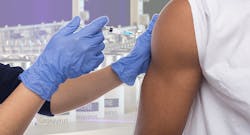Editors Note: Over the course of this week, Machine Design will be sharing a series of articles addressing the development and distribution of the COVID-19 vaccine—and the obstacles surmounted along the way. Be sure to check out the other installments below:
- Speed Bumps on the Road to Delivering COVID Vaccines
- Global Manufacturers Fine-Tune Strategies
- COVID Vaccine Moves to the Front of the Supply Chain
- Thanks for Sharing: Reusable Open Source Hardware Respirators
It ends at the point of a needle, but the COVID-19 vaccine’s long journey from manufacturing plants to a world of patients waiting for its protection is anything but that precise.
It has required the merger of existing platforms and innovative technologies to deliver on the promise of vaccines to curtail a global pandemic that has killed more than 350,000 and infected more than 20 million in the United States alone. The accelerated testing and verification of COVID-19 vaccines from three major manufacturers—the Pfizer/BioNTech and Moderna vaccines in the U.S. and AstraZeneca’s vaccine in the United Kingdom—were made possible in part through the use of advanced manufacturing techniques such as artificial intelligence.
The website Frontiers, an open-source science platform, noted that the use of AI in cataloging and modeling the toxicity of potential compounds and their interaction.
“Artificial intelligence has been applied to many subfields of drug discovery and vaccine development. This improvement is crucial for the current situation and immediate (COVID-19) therapy discovery for several key reasons,” an article on the website noted. “Firstly, the automatic feature extraction ability of deep learning can support models with better accuracy and deliver more reliable results. Secondly, the generative ability demonstrated by deep learning models can be utilized to create more druggable molecules and better epitope prediction, lowering the chance of failure in the trial pipeline. Lastly, the novelty of the virus causes the data around its possible therapies to be scarce, which is a suitable scenario for transfer learning and leveraging the learned knowledge from previous tasks.”
“Therefore, the use of deep learning in therapy discovery for (COVID-19) is essential in order to make a timely and accurate response to the virus,” the article states.
Getting To “the Point”
The development of the vaccine itself was a monumental achievement; its initial distribution was an event for a world that was longing for a bit of good news in the gloom of the pandemic. When Pfizer first announced that shipments had begun from its Kalamazoo, Mich. plant in December, it was treated with the kind of news coverage reserved for returning championship sports teams.
The challenges of moving the vaccine, which required super-cold transportation on the road and similar storage at the distribution routes along the way, proved to be another hurdle for manufacturing and distribution professionals.
Shipments of the vaccine must remain temperature-controlled, maintaining recommended storage conditions of −70°C (±10°C) for extended periods of time with dry ice. Each carrier contains a GPS-enabled thermal sensor to track the location and temperature of each vaccine shipment 24/7. Once thawed, the vaccine vial can be stored safely for up to five days in refrigerated conditions.
“This is among the most important work in the history of our company, and we’re honored to be a part of the effort to help end this pandemic,” Raj Subramaniam, president and CEO of FedEx Corp., said in a statement in December. “I am immensely proud of our dedicated team members who continue to go above and beyond to help ensure the safe movement of these critical COVID-19 vaccines, especially during our busiest holiday shipping season to date.”
FedEx said its network of temperature-control solutions and near real-time monitoring capabilities is “well-positioned to handle COVID-19 vaccine shipments around the world.”
The vaccine transportation strategy was the result of a coordinated plan between manufacturers, distributors, supply chains and the hospitals and health care professionals who received the vaccine. “This is the moment of truth we’ve been waiting for at UPS,” Wes Wheeler, president of UPS Healthcare, said in a December statement. “We have spent months strategizing with (the federal government’s) Operation Warp Speed officials and our healthcare customers on efficient vaccine logistics, and the time has arrived to put the plan into action.”
There have been blips in the process. Pfizer officials issued a statement Dec. 17 indicating that it was awaiting shipping instructions on additional doses ready after the initial distribution date.
“Pfizer has a successful and long track record of producing and distributing large volumes of complex vaccines that the world can trust—and we are continuing to extend this track record with our COVID-19 vaccine,” company officials said in a press release. “Over the last several months, we have activated Pfizer’s extensive manufacturing network, including thousands of highly skilled workers in multiple locations. As a result, Pfizer is manufacturing and readying for release millions of doses each day, and that volume will grow over the coming weeks.
“We remain confident in our ability to deliver up to 50 million doses globally this year and up to 1.3 billion next year,” Pfizer officials added, “and we look forward to continuing to work with the U.S. Government to deliver our vaccine to the American people.”
“Making” The Point
Pharmaceutical manufacturing typically is a process that doesn’t get a lot of attention, nor does it invite a lot of attention. But the size and scope of the COVID-19 project has brought those processes to the fore—particularly the speed of the process.
“It is common practice when a drug/vaccine indicates promising results in early clinical trials (Phase 1 and 2) that manufacturers initiate production construction as the validation approval of these facilities can take years,” said Mike Severino, national sales manager for Biopharma & Cosmetics at Festo. “In the case of COVID-19, several manufacturers embraced existing Contract Manufacturing Organization (CMO) facilities, which expedited early-stage production. Another option for smaller scale production was the application of single-use equipment or what many people refer to as disposable components vs. stainless steel fixed in-place equipment.”
The urgency of the effort to combine the Operation Warp Speed initiative with the practical issues of safety creating a vaccine also saw some typical barriers scaled quickly. “The two presently approved vaccines are based on mRNA technology which allowed existing biotech manufacturing facilities to quickly adopt the process requirements which were already in house,” Severino said. “This technological approach is being evaluated not just for vaccines but other medical treatments for certain cancers and immune deficiencies. The technology illustrates the breath of the mRNA production and how this approach can be adapted to solutions for many different illnesses.”
Severino noted the fast movement from proven vaccine to manufacturing. “The single biggest a-ha moment is the fact that when government and the private sector are focused on a common goal without unnecessary barriers, miracles can be accomplished,” he said.
There are lessons to be gained from this process for future efforts in and out of the pharmaceutical space. “The life science industry is a relatively small community as information/technology/processes are commonly shared within the community,” Severino said, noting the International Society of Pharmaceutical Engineers provides an ongoing connection for the most up-to-date training and best-in-class approaches to dealing with issues such as the pandemic. “As a result, the industry has the ability to adapt,” Severino said. “What I believe we were not prepared for was the level of public interest in the development process.
“One can make the case that our inability to rapidly manage mass quantities of testing and the testing supply chain would be the pandemic’s single most important wake-up call,” Severino continued. “Building and operating a delivery model to produce, administer and test samples utilizing a nationally choreographed protocol is essential for improving the response to the next contagion event.
While the vaccine has justly received the largest part of the attention, other manufacturers also have ramped up their manufacturing efforts.
For example, Healthcare Purchasing News reported in December that Becton, Dickinson and Company (BD), the world’s largest manufacturer of medical syringes, has received orders for more than 1 billion injection devices. The company already has shipped more than 300 million devices and expects to fulfill its current orders by the end of 2021. It already has told customers to begin placing orders for the end of 2021 and into 2022.
“This milestone is more than just a number—it represents hundreds of millions of people around the world, such as frontline workers and at-risk loved ones who will now be able to receive a vaccination the moment vaccines are available,” said Rick Byrd, president of Medication Delivery Solutions for BD. “We recognize our manufacturing and supply chain teams who are working around-the-clock to make and deliver these essential devices throughout the world.”
BD is preparing for the longer-term expectations for global vaccinations. These efforts include a $70 million capital project to further expand BD’s operations and manufacturing capacity in Nebraska. The new capacity is expected to be online in summer 2021 and once completed, the federal government will have priority access to hundreds of millions of injection devices to support vaccination efforts for COVID-19 and future pandemics.
The company also is investing approximately $1.2 billion over a four-year period to expand and upgrade manufacturing capacity and technology for pre-fillable syringes and advanced drug delivery systems to allow for continued growth of new injectable drugs and vaccines, but also provide surge capacity for increased pre-fillable syringe demand during times of pandemic response.
Getting To The Point
Another area of disruption has been in a supply chain that already was stretched by the imposition of global tariffs and the need to find a new supply of near-plant parts and materials. The COVID-19 challenges only compounded that problem.
“There are a lot of companies that have been single-sourcing,” Lee A. Clair, the managing partner of Transportation and Logistics Advisors, told a supply chain conference call presented by Stifel Capital Markets in September. “With all the disruption happening, the push now is towards having multiple suppliers of most key components.”
As reported by Fleet Owner magazine, Clair said the pandemic has changed the supply chain rules—perhaps permanently. “As we look going forward, wherever you are today in your supply chain—big companies, small company, sophisticated, unsophisticated—you’re probably not well-positioned for the future because things keep moving more today than ever before,” Clair said. “Because even if you did a good job of planning for your future, disruption of this whole COVID scenario is making for a different future than what you would have planned pre-COVID.”
Cristina Commendatore of American Trucker, Josh Fisher of Fleet Owner, and the staff of Healthcare Purchasing News, all Endeavor Business Media publications, contributed to this article.
About the Author

Bob Vavra
Editor Emeritus, Machine Design and Power & Motion
Bob Vavra is the former senior content director of Machine Design and Power & Motion.
